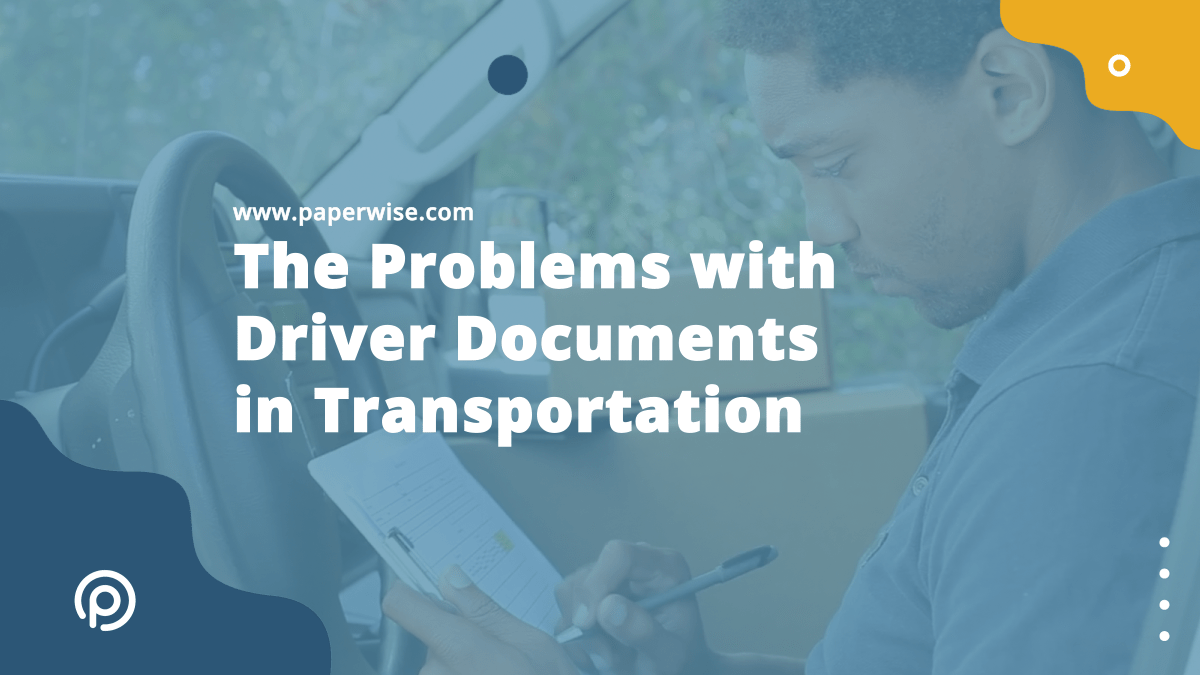Many transportation companies face difficulties in getting documents back from drivers so they can bill on time. This problem isn’t new or rare, but each twist in the document chain adds days to your DSO. You don’t get paid until you can deliver accurate documents, but that takes time. It isn’t unusual for us to see at least 30-90 days difference in DSO windows between a best-in-class transportation billing process and an average process:
- 7+ days: Getting documents from the road. You have many different trucks dropping off freight across the nation. Those drivers face struggles getting documents back to you in a timely fashion from the road. Depending on the method you use to transmit documents it is standard for this process to take about a week’s time, adding seven days to your DSO.
- 3+ days: Indexing and routing. Of course, even when the documents do arrive, it isn’t immediately obvious where they belong. Someone in your back office must index the documents to the right client and the right load and then route them for review and invoicing.
- 30+ days: Errors and missing information. Now the paperwork is in and routed properly but something isn’t right. There’s a question about the number of pieces or the number of pallets or maybe a missing signature but at this point, the driver can’t remember the exact information from a load dropped off two weeks ago. It’s not uncommon for missing documents to lead to over 100 days of DSO on a particular load but averaged over all of your documents and loads most companies are suffering at least a month of extra processing time. You have multiple documents per load, but a single missing document such as a POD can crater the billing on a load. So just at 6% rate of missing or illegible documents can wreck the billing cycles of 30% or more of your loads.
- 7+ days: Manual processes and other bottlenecks. Even when the documents are 100% accurate, what are the next steps in your workflow? How do you enter information and submit an invoice for processing? It doesn’t take many loads to flood your team with scale tickets, detention fees, PODs and more.
What if you could measure DSO from a signed proof of delivery to invoice in minutes, not days?
What Doesn’t Work
The margins in the transportation industry are extremely thin. You run a tight, cash-flow business but you don’t get paid until you can deliver accurate documents.
You know you need to improve your document-to-invoice process, but you might wonder where to start or if it’s even worth it. This is because as an industry, we have traditionally attacked this problem with the wrong solutions:
- Scanning kiosks: Service locations are limited so your driver has to hold on to bundles of documents until the next scanning kiosk. Then your driver has to do a lot of manual preparation with stickers and cover sheets that don’t necessarily match up to your systems at HQ.
- In-cab devices: These devices are expensive to install and maintain and very unpopular with drivers. If you own all of your power units you can mandate installation across your fleet, but what do you do with independent drivers or new trucks?
- Office drop off: Depending on your locations and the geographic areas you serve, you might have your drivers drop off their documents when they get back to HQ. Of course, that means your drivers have to be good at keeping them organized inside their cabs and you still get the documents late and with no indexing information.
- Emailing: Sending load documents through email might seem like a step in the right direction until you consider the fact that most smart phone photos are extremely large in file size, may not be easy to read and drivers have inconsistent Wi-Fi access on the road.
- Driver apps: Most mobile TMS apps are overkill – too expensive, too hard to use and too much confusing functionality.
You Need a Transportation-friendly Solution
When you look at the previously available options for mobile capture, it’s no wonder many transportation companies were reluctant to adopt those solutions.
Here are some of the biggest complaints we’ve heard from drivers and back-office employees about other methods that don’t work the way they work:
- “My company rolled out a new TMS system application but it’s too difficult to use. I just want a simple way to get my documents in.”
- “So many of these apps rely on the phone camera resulting in very large file sizes. It eats up our cell data budget, it is slow, Wi-Fi access is spotty at best and our team has to resize each of the images when they get them back at the office. Sometimes I think I sent an image but my phone messaging keeps timing out.”
- “I can’t read about a third of the images I get from drivers. The lighting is bad, they’re crooked, shadows and coffee stains cover important information.”
- “I have to manually match each image and document back into my TMS system and a lot of times I’m starting from scratch. I usually at least know which driver sent me the images, but I have to find the load numbers to look up the rest.
- “If there is something wrong with my document or a missing signature, my office doesn’t call me for two weeks. I can’t remember what I had for breakfast let alone details of a load from that long ago.”
- “I’ve come to dread seeing the FedEx delivery man. I never know what I’m going to find in the piles of paper in all of those envelopes.”
So we set out to address the most important concerns in our solution:
- High quality images at low file sizes
- Built-in indexing and real document management
- Driver friendly, easy to use and get started
- Less expensive than other solutions
Learn More about Paperwise Capture
If you’d like to learn more, please view our video: Mobile Capture for the Trucking Industry
Or request a free consultation to see first hand how Paperwise Capture can work for your company.




